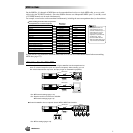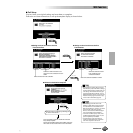
MIDI Functions
MIDI Functions
176 Reference
Receive Settings
This display page allows you to specify the MIDI receive mode for each 9000Pro MIDI
channels, and to specify which types of data will be received via each channel.
The explanations here apply to step #5 of the Basic Procedure on page 174.
MIDI Receive Mode
OFF No MIDI data is received.
XG/GM This is the “Multi-Timbre” mode in which the corresponding channel of the internal XG/GM tone
generator is directly controlled by the received MIDI data. XG/GM can only be used with chan-
nels 1 - 16. It cannot be used with channels 17 - 32.
RIGHT 1 The RIGHT 1 part is controlled by the MIDI data received on the corresponding channel.
RIGHT 2 The RIGHT 2 part is controlled by the MIDI data received on the corresponding channel.
RIGHT 3 The RIGHT 3 part is controlled by the MIDI data received on the corresponding channel.
LEFT The LEFT part is controlled by the MIDI data received on the corresponding channel.
KEYBOARD MIDI note data received by the 9000Pro plays the corresponding notes in the same way as if
they are played on the keyboard.
ACMP
RHYTHM1~2
The received notes are used as the accompaniment RHYTHM 1 and RHYTHM 2 notes.
ACMP BASS The received notes are used as the accompaniment BASS notes.
ACMP
CHORD1~2
The received notes are used as the accompaniment CHORD 1 and CHORD 2 notes.
ACMP PAD The received notes are used as the accompaniment PAD notes.
ACMP
PHRASE1~2
The received notes are used as the accompaniment PHRASE 1 and PHRASE 2 notes.
Select a Channel.
The Rx MONITOR indicates
when data is being received on
any of the 32 MIDI channels:
The dots corresponding to each
channel (1 - 32) flash briefly
whenever any data is received
on the channel(s).
Turn reception of the specified data type on
or off.
See below for details on the data types.
Select a Mode for the selected channel.
See below for details about the receive modes.
• Channels 1 - 16 are handled
with the MIDI A terminals or
the TO HOST terminal; chan-
nels 1 - 16 of a second MIDI
port or device are handled as
channels 17 - 32 with the MIDI
B terminals.
Data types in the MIDI TRANSMIT/RECEIVE display
Note.........................Messages which are generated when the keyboard is played.
Each message includes a specific note number which corresponds to the
key which is pressed, plus a velocity value based on how hard the key is
played.
Cntcng.....................The abbreviation of “Control Change.”
Control change data includes modulation wheel, foot controller, and any
other controller data (except the pitch bend wheel, which has its own
switch, below).
Prgcng.....................The abbreviation of “Program Change.”
Program change data corresponds to voice or “patch” numbers.
Pitch Bend...............Refer to page 59
After Tch..................Refer to page 60
174


















